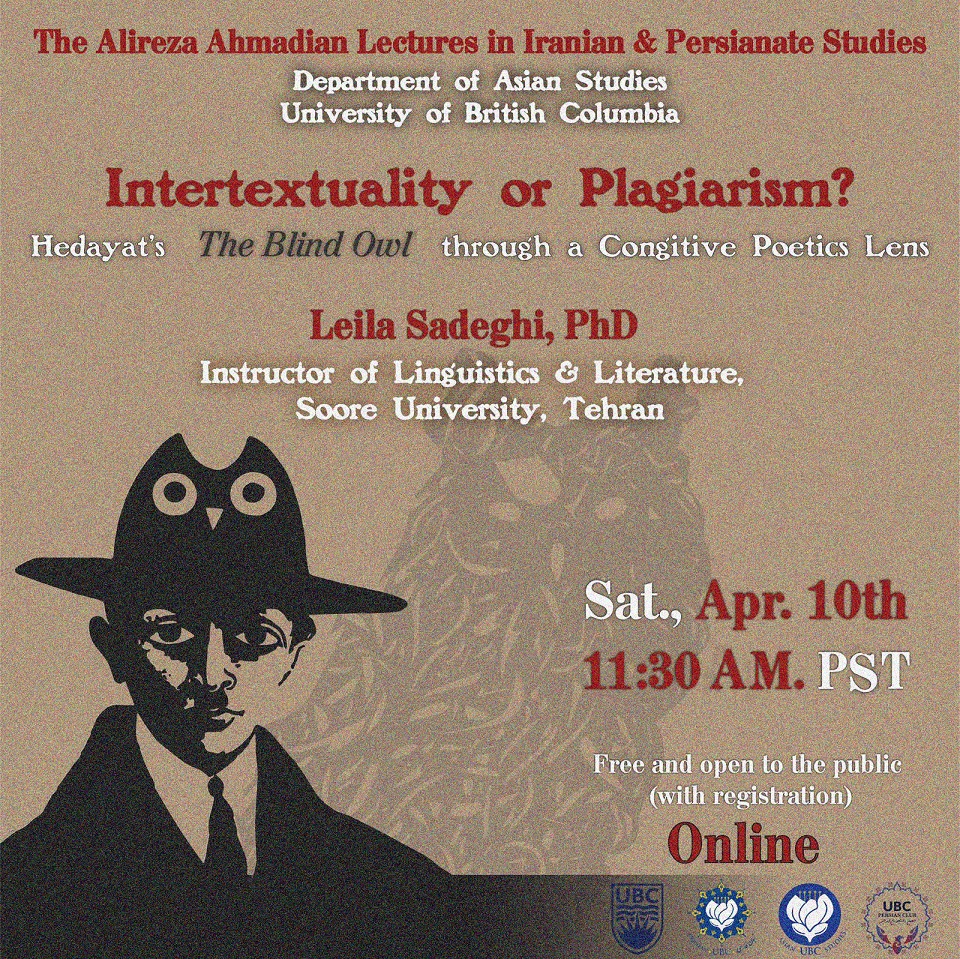ورود به سایت دانشگاه جهت ثبت نام (رایگان)
بررسی بوف کور اثر صادق هدایت با رویکرد شعرشناسی شناختی
سخنران: لیلا صادقی
دانشگاه بریتیش کلمبیا، 10 آوریل (21 فروردین)، ساعت 11.30 صبح به وقت ونکوور، ساعت 11 شب به وقت تهران
گرچه سرقت ادبی به معنای «انتشار و یا ارائه یک ایده به عنوان ایده جدید یا اصلی است که در واقع از ایده دیگری مشتق شده»، غالبن با بینامتنیت که «شکلگیری معنای متن توسط متون دیگر» است، در کاربرد خلط میشود، هرچند هدف این دو کاملن متفاوت است، اما شباهت آنها تا حدی است که مخاطب را میان دو جهان کپی یا تازه سرگردان میکند و درنتیجه سوءتفاهمهای بسیاری برای فهم اثر ایجاد میشود. چنین بحثهایی درباب بوف کور (1315) نوشتهی صادق هدایت گاه و بیگاه پیش میآید و کسانی اثر او را به دلیل خلط این دو مبحث با شبهاتی روبرو می کنند که در این مجال و با رویکرد شعرشناسی شناختی، با ارائهی تعریف بینامتنیت از منظر شناختی و ارائهی قابهای بینامتنی متفاوت در شکلگیری آثار مختلف و همچنین ارائهی الگویی طرحوارهای از منظر شناختی برای سطوح متفاوت سرقت ادبی قصد دارم تفاوت عملکرد بینامتنیت و سرقت ادبی را در شکلگیری یک اثر نشان دهم و درنهایت نشان دهم بوف کور که چطور با آثار متفاوتی از جمله هملت (1602) اثر ویلیام شکسپیر، اورلئا (1855) اثر ژرار دو نروال، دفترهای مالده لائوریس بریگه (1910) اثر ماریا ریلکه، دانشجوی پراگ (1913) به کارگردانی اشتلان ریه و پل واگنر با الهام از داستان ادگار آلن پو، تار (1918) اثر وندهام لوئیس، ملوزین (1920) اثر فرانتس هلنس، مطب دکتر کالیگاری (1920) اثر روبرت وینه، نوسفراتو (1922) به کارگردانی فردریش ویلهلم مورنائو، نادیا (1928) اثر آندره برتون، خشم و هیاهو (1929) اثر ویلیام فاکنر، خون یک شاعر (1930) به کارگردانی ژان کوکتو، موجها (1931) اثر ویرجینیا ولف و بسیاری از دیگر آثار در بینامتنیتی است که منجر به گفت و گوی اثر با جهان پیرامون و شکلگیری جهان تازه ای میشود که بدون آشنایی با بینامتنیتها، بخشی از این جهان تازه کشف نشده باقی میماند.
کلیدواژه: بینامتنیت، بوف کور، طرحواره، سرقت ادبی، شعرشناسی شناختی
Intertextuality or Plagiarism?
Hedayat's The Blind Owl" through a Cognitive Poetics Approach
Leila Sadeghi, PhD
Plagiarism is defined as “presenting someone else’s work or ideas as your own, with or without their consent, by incorporating it into your work without full acknowledgement.” It is, however, often mistaken for intertextuality, which is used to “designate the various relationships that a given text may have with other texts.” Despite their different goals, plagiarism and intertextuality are sometimes mistaken for each other due to their overlap in their drawing on others’ texts and the fact that they keep readers wandering between two worlds, i.e., that of the cited/copied text and that of the new one. Sadeq Hedayat’s The Blind Owl (1936) has often become the subject of a heated debate on the difference between intertextuality and plagiarism; indeed, The Blind Owl has been explicitly accused of plagiarism by some scholars who do not find a clear and practical border between plagiarism and intertextuality.
In this presentation, using The Blind Owl as a point of reference, and drawing on notions and theories in Cognitive Poetics, I will attempt to differentiate plagiarism from intertextuality, while also briefly pointing out the intertextual relations between The Blind Owl and a good number of other texts, including William Shakespeare’s Hamlet (1602); Gérard de Nerval’s Aurélia (1855); Rainer Maria Rilke’s Malte Laurids Brigge’s Notebooks (1910); Stellan Rye & Paul Wegener’s The Student of Prague (1913); Wyndham Lewis’s Tarr (1918); Franz Hellens’s Mélusine, Ou, La Robe De Saphir (1920); Robert Wiene’s The Cabinet of Dr. Caligari (1920); Friedrich Wilhelm Murnau’s Nosferatu (1922); André Breton’s Nadja (1928); William Faulkner’s The Sound and the Fury (1929); Jean Cocteau’s The Blood of a Poet (1930); Virginia Woolf’s The Waves (1931), etc. In its intertextual connections with these and other texts, The Blind Owl enters into a dialogue with them in order to project an innovative world—a world which would remain partly undiscovered were we not to familiarize ourselves with these intertexts.
Keywords: Intertextuality, The Blind Owl, Schema theory, Plagiarism, Cognitive Poetics.
